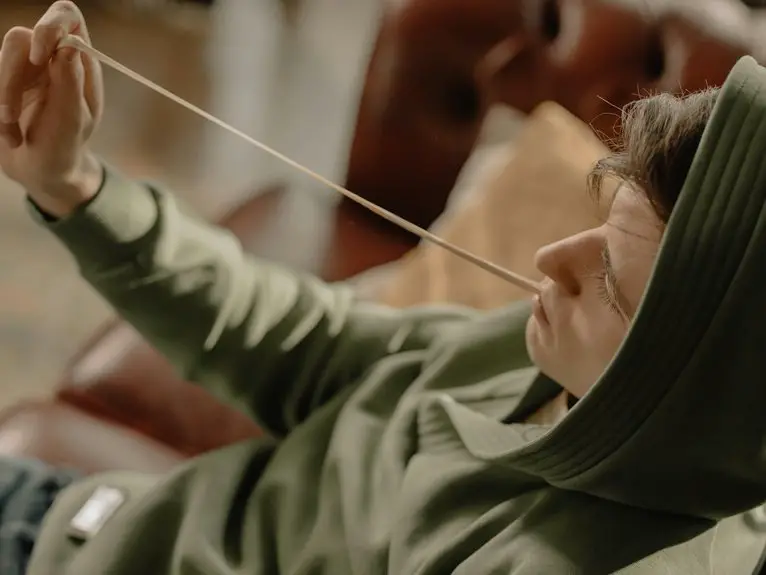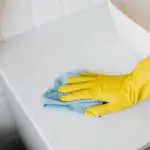If you’ve got super glue or chewing gum on your leather sofa, start by gently softening the glue with acetone-free nail polish remover or hardening the gum with ice wrapped in cloth. Carefully lift the residue with a plastic scraper or your fingernail to avoid damage. Clean the area with mild soap and water, then condition the leather to restore moisture. If the stain won’t budge or the leather feels damaged, more detailed steps can help you handle it safely.
Table of Contents
Key Takeaways
- Test all cleaning products on a hidden spot to avoid discoloring or damaging the leather surface.
- Use ice to harden chewing gum, then gently lift it with a dull knife or fingernail.
- Apply acetone-free nail polish remover on a cotton swab to soften super glue, then carefully scrape it off.
- Clean the area with a mild soap solution and a soft cloth, avoiding harsh chemicals that harm leather.
- Condition the leather after cleaning to restore moisture and prevent cracks or dryness.
Assessing the Damage on Your Leather Sofa
Before you start removing super glue or chewing gum, take a close look at the affected area on your leather sofa.
Check how large the stain or residue is and note whether it’s on smooth or textured leather. You’ll also want to see if the glue or gum has hardened or remains sticky.
Assess the size and texture of the stain, noting if the glue or gum is hard or sticky.
Inspect the surrounding area for any discoloration or damage to the leather’s finish. This helps you decide the best removal method and avoid causing further harm.
If the leather feels rough or cracked near the spot, proceed cautiously. Understanding the extent of the damage guarantees you choose safe, effective techniques tailored to your sofa’s type and condition.
This step saves you time and protects your leather investment.
Removing Super Glue From Leather Safely
Although super glue bonds quickly and firmly, you can remove it from your leather sofa without causing damage by using gentle, targeted methods.
Start by softening the glue with a cotton swab dipped in acetone-free nail polish remover. Dab carefully—avoid rubbing—to prevent spreading the glue or harming the leather’s finish.
Once softened, gently lift the glue using a plastic scraper or your fingernail, working slowly to avoid tearing the surface. If residue remains, clean the area with a leather-safe cleaner and a soft cloth.
Always test any product on an inconspicuous spot first to ascertain it won’t discolor or damage the leather. Patience and a delicate touch are key to safely removing super glue without ruining your sofa’s appearance.
Techniques to Soften and Lift Chewing Gum
To tackle chewing gum on your leather sofa, start by applying ice to harden it, making removal easier.
Once it’s firm, use a bit of oil to gently loosen the gum without damaging the leather.
These simple steps help you lift the gum cleanly and safely.
Applying Ice for Hardening
When you apply ice to chewing gum stuck on your leather sofa, you harden it, making removal much easier.
Start by wrapping a few ice cubes in a thin cloth or use an ice pack, then press it firmly against the gum for about 10 to 15 minutes. This cold treatment solidifies the gum, reducing its stickiness and preventing it from smearing or spreading as you remove it.
After the gum hardens, use a dull knife or your fingernail to gently lift the edges. Be careful not to scratch the leather surface. If needed, reapply the ice to keep the gum firm during removal.
This method is safe and effective, helping you avoid damage while making cleanup quicker and less frustrating.
Using Oil to Loosen
Once the gum has hardened and you’ve lifted its edges, using oil can help soften it further for easier removal.
Apply a small amount of baby oil, olive oil, or even peanut oil onto a cotton ball or soft cloth. Gently dab the oil onto the gum, allowing it to seep in and break down the sticky texture. Let it sit for about 5 to 10 minutes to loosen the gum without damaging the leather.
Then, carefully scrape the gum off with a plastic scraper or your fingernail, working slowly to avoid tearing the leather.
Afterward, clean the area with a mild leather cleaner and a damp cloth to remove any oily residue and restore the sofa’s finish.
Cleaning Residue Without Harming Leather
A careful approach helps you remove glue or gum residue without damaging your leather sofa.
After loosening the substance, focus on cleaning the area gently to protect the leather’s finish.
Follow these steps:
- Use a soft cloth: Dampen it slightly with warm water to avoid soaking the leather.
- Mild soap solution: Mix a few drops of gentle soap with water and wipe the area carefully.
- Avoid harsh chemicals: Stay away from alcohol, acetone, or abrasive cleaners that can strip the leather’s color.
- Dry and condition: Pat the area dry with a clean towel, then apply a leather conditioner to restore moisture and prevent cracking.
This method guarantees residue removal while maintaining your sofa’s look and feel.
Preventative Care to Avoid Future Stains
Although accidents happen, you can protect your leather sofa by taking simple preventative steps that minimize the risk of stains from super glue, chewing gum, and other sticky substances.
Start by setting clear rules about eating or using adhesives near the sofa. Encourage family and guests to keep sticky items away.
Establish clear rules to keep eating and adhesives away from your leather sofa to prevent sticky stains.
Use washable throws or slipcovers during activities that might cause spills or sticky messes.
Regularly clean and condition your leather to maintain its protective finish, making it less prone to absorbing stains.
Keep a small emergency kit with leather-safe wipes or mild cleaners nearby to address spills immediately.
When to Seek Professional Leather Cleaning Help
If you notice deep scratches, discoloration, or persistent stains after your efforts, it’s time to call in a professional.
You’ll want to find a leather specialist who understands your sofa’s material and can handle delicate cleaning.
Don’t risk making the damage worse by trying to fix severe issues on your own.
Signs of Severe Damage
Signs of severe damage on your leather sofa include deep cracks, discoloration that won’t fade, or sticky residues that resist gentle cleaning.
When you notice these issues, it’s a clear signal to contemplate professional help to prevent further deterioration.
Look out for these specific signs:
- Leather peeling or flaking away from the surface.
- Persistent stains or glue marks that remain after home treatments.
- Areas where the leather feels brittle or unusually stiff.
- Significant color changes that don’t respond to cleaning products.
If you see any of these signs, avoid DIY fixes that might worsen the damage.
Instead, consult a leather expert to restore your sofa’s appearance and extend its lifespan effectively.
Choosing a Leather Specialist
When your leather sofa shows severe damage beyond what home remedies can handle, reaching out to a professional becomes the best option. You want to choose a specialist who understands leather care and restoration to prevent further harm. Consider their experience, customer reviews, and the methods they use. Don’t hesitate to ask about their success with glue and gum stains specifically.
| Factor | What to Look For | Why It Matters |
|---|---|---|
| Experience | Years in leather cleaning | Expertise in tough stains |
| Reviews | Positive client feedback | Reliability and trustworthiness |
| Methods | Safe, leather-friendly products | Prevents additional damage |
| Guarantees | Service warranties | Peace of mind and accountability |
Choosing wisely guarantees your sofa gets the best care and a better chance at full restoration.
Frequently Asked Questions
Can Super Glue or Gum Damage Leather’s Color Permanently?
Yes, super glue or gum can permanently damage your leather’s color if left too long or removed harshly. You’ll want to act quickly and gently to avoid stains or discoloration that might be tough to fix.
Are There Specific Leather Types More Resistant to Glue or Gum?
You’d think some leather types repel glue or gum like superheroes, right? Sadly, most leathers aren’t that lucky; full-grain leather resists stains better, but no leather’s truly immune—so, handle sticky stuff with care, okay?
Is It Safe to Use Household Solvents on All Leather Sofas?
You shouldn’t use household solvents on all leather sofas since some can damage finishes or cause discoloration. Always test a small hidden spot first, and opt for products specifically designed for leather care to stay safe.
How Long Should You Wait Before Treating Fresh Glue or Gum?
Think of fresh glue like hot wax on your finger—it’s best to wait 10-15 minutes before treating it. This lets it firm up slightly, making removal easier without spreading or damaging the surface.
Can Pets Cause Similar Damage to Leather Upholstery?
Yes, pets can cause similar damage to your leather upholstery by scratching or chewing on it. You’ll want to keep their nails trimmed and provide alternatives to protect your sofa from scratches or tears.
- Why Nonwoven Fabrics Are Ideal for Disposable Textiles - July 9, 2025
- When to Use Woven vs. Nonwoven Geotextile for Your Project - July 9, 2025
- What to Know About the Global Nonwoven Market Volume - July 9, 2025







